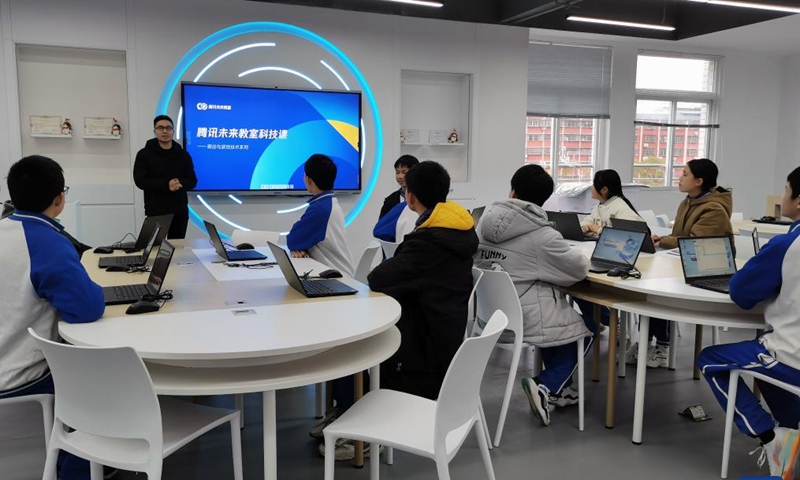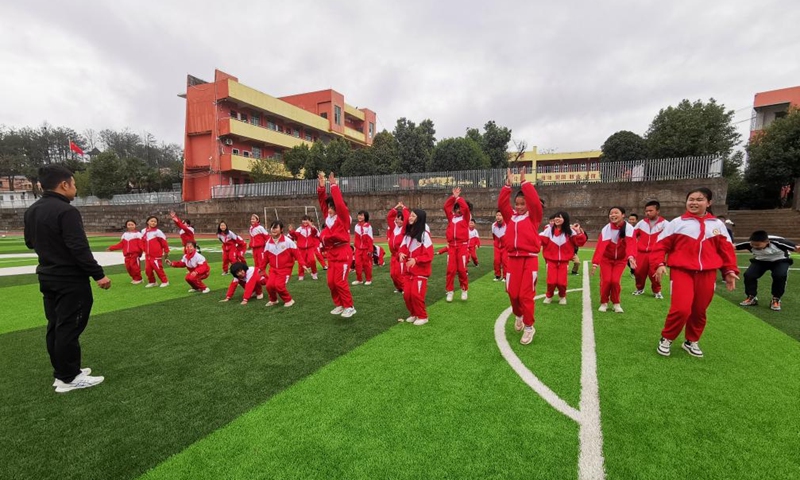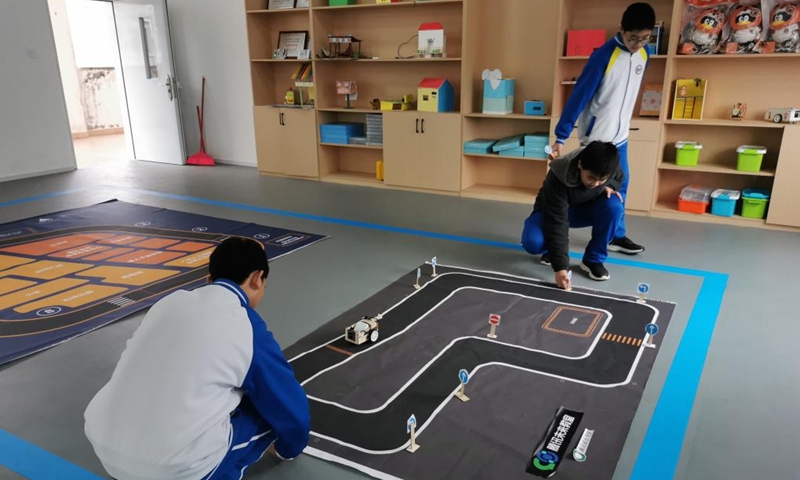
Students of the Ruyuan Ethnic Experimental School have a class in a "Future Classroom" in Shaoguan, south China's Guangdong Province, Feb. 9, 2023.(Xinhua/Wang Feng)

Students of the Red Army School of Marshal Chen Yi take physical education class in Nanxiong, south China's Guangdong Province, Feb. 10, 2023.(Xinhua/Wang Feng)

Students of the Ruyuan Ethnic Experimental School operate remote-controlled cars in a "Future Classroom" in Shaoguan, south China's Guangdong Province, Feb. 9, 2023.(Xinhua/Wang Feng)
Half a year ago, Yu Jinghui, a 12-year-old junior high school student in Shaoguan City, south China's Guangdong Province, took a step toward his dream through programming, thanks to a futuristic classroom.Yu's home is located in Ruyuan County of Shaoguan City, a mountainous county less than 400 kilometers away from China's economic powerhouse Shenzhen.
Despite the short distance, Ruyuan lags behind in terms of its economic development level. In 2021, its per capita disposable income was about 32,000 yuan (about 4,642 U.S. dollars), less than half of that in Shenzhen.
Despite its relative lack of development, Ruyuan managed to build a futuristic classroom for students there, igniting many dreams of local students, including Yu's.
In February 2022, a "Future Classroom" was built at the Ruyuan Ethnic Experimental School in Shaoguan where Yu studies as a junior school freshman. The classroom is equipped with not only computers and software for programming, but also circuit boards and chips for making remote-controlled cars, hand tools for making models and 3D printers.
The "Future Classroom" allows students like Yu to see broader uses of computers and mobile phones beyond just playing games -- they get to view better opportunities and potentials for personal development.
After just four months of practice in the room, Yu participated in the national information technology innovation and practice competition for primary and secondary schools and secured first place in the provincial final.
His first place finish resulted from a mini game he created called "Little Girl Plus Smart Wardrobe." When users choose the destination or activity they want, the smart wardrobe automatically chooses the corresponding clothes for the little girl.
"I designed this little girl in the image of my sister. I have always wanted to make a smart wardrobe for my sister. I hope to make a real one for her in the future," said Yu, who showed great dedication to the "Future Classroom" programming course over the past year.
"Programming is very interesting. Just like playing games, I can live out my dreams on the computer by writing programs. I have gained a sense of accomplishment, while my logical thinking and practical abilities have been greatly improved," said the boy, who now spends hours every day delving into programming.
"The school prepared sufficient hardware equipment for IT courses and set 200 lessons in the past year, covering all the students in Junior 1 and Junior 2," said Tan Qiuqiang, teacher in the "Future Classroom."
The "Future Classroom" is a microcosm of the balanced development of education continuously promoted by the Chinese government and society in recent years.
As an important part of ensuring equal access to education, more and more quality education courses have been introduced to primary and secondary schools in remote mountainous areas, so as to better realize development in an all-around way for students across a wider range.
It has been proven that children in mountainous areas can achieve amazing results if provided with opportunities and platforms. In October 2022, a total of 14 students from two schools in Shaoguan participated in a friendly contest for AI innovation. In the end, the Ruyuan Ethnic Experimental School team secured the runner-up spot after competing against more than 20 teams from across the country.
Meanwhile, located some 170 kilometers away from Ruyuan Ethnic Experimental School, a brand new "Future Sports Ground" was established in July 2022 at the Red Army School of Marshal Chen Yi in Nanxiong, Guangdong.
"I'm so happy. The old sports ground used to be full of holes, but now I can roll on the lawn," said Zhu Tongtong, a third-grade primary school student.
In addition to hardware facilities, the "Future Sports Ground" also provides a series of software services such as courses and sports events. Students also have access to a digital physical education resource library, which contains rich content such as sports games and physical training teaching.
Over the past year, the project team has held 5 activities at the school, enriching the sports experience of 1,007 students and teachers.
"With the support of the new sports grounds, and access to equipment and curriculum libraries, children have more opportunities to explore new things, while PE lessons are more diverse than before, making lessons much more enjoyable for children," said He Yonghong, vice president of the Red Army School.
By the end of January this year, 30 "Future Sports Grounds" had been built, offering a total of 20,463 classes and seeing the participation of 805,200 students. Meanwhile, 36 "Future Classrooms" had been established, covering 14 provinces across the country, with a total of 4,830 classes and the participation of more than 169,800 students, according to Zheng Zhong, director of the program initiator Tencent Minors Guidance Center.
"We hope that the 'Future Classroom' will allow more children to learn about cutting-edge technology, to broaden their horizons, and use the Internet scientifically, while we also hope that children will have strong physiques and that they will embrace the future," she said.
